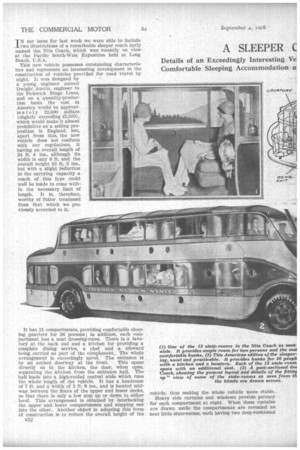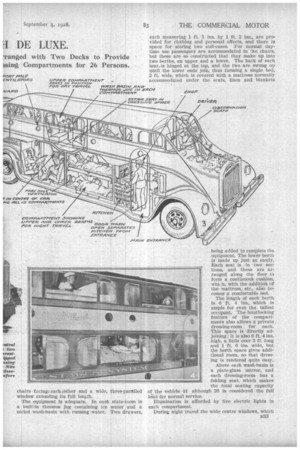A SLEEPER C HI DE LUXE.
Page 16

Page 17

Page 18

If you've noticed an error in this article please click here to report it so we can fix it.
Details of an Exceedingly Interesting Ye Comfortable Sleeping Accommodation a:
-ranged with Two Decks to Provide 3sing Compartments for 26 Persons. IN our issue for last .week we were able to include two illustrations of a remarkable sleeper coach aptly
named the Nite Coach, which was recently on view at the Pacific South-West Exposition held at Long Beach, U.S.A.
This new vehicle possesses outstanding characteristics and represents an interesting development in the construction of vehicles provided for road travel by night. It was designed by
a young engineer named Dwight Austin, engineer to the Pickwick Stage Lines, and on a quantity-production basis the cost in America would be approximately 22,000 dollars (slightly exceeding £5,500), which would make it almost prohibitive as a selling proposition in England, but, apart from this, the new vehicle does not conform with our regulations, it having an overall length of 34 ft. 4 ins., although its width is only 8 ft. and the overall height 10 ft. 3 ins., but with a slight reduction in the carrying capacity a coach of this type could well be made to come within the necessary limit of length. It is, therefore, worthy of fuller treatment than that which we previously accorded to it.
It has 13 compartments, providing comfortable sleeping quarters for 26 persons ; in addition, each compartment has a neat dressing-room. There is a lavatory at the back end and a kitchen for providing a complete dining service, a chef and a steward being carried as part of the complement., The whole arrangement is exceedingly novel. The entrance is by an arched doorway at the front. This opens directly on to the kitchen, the door, when open, separating the kitchen from the entrance hall. The hall leads into a high-roofed central aisle which runs the whole length of the vehicle. It has a headroom of 7 ft. and a width of 1 ft. 8 ins., and is located midway between the floors of the upper and lower decks, so that there is only a low step up or down to either level. This arrangement is obtained by interlocking the upper and lower compartments and stepping one into the other. Another object in adopting this form of construction is to reduce the overall height of the
K.12
vehicle, thus making the whole vehicle more stable.
Heavy side curtains and windows provide privacy for each compartment at night. When these curtains are drawn aside the compartments are revealed RS neat little state-rooms, each having two deep-cushioned chairs ,facingi.each Aother and a wide, three-panelled window extending its full lenM.
The equipment Is adequate. In each state-room is a built-in thermos jug containing ice water and a nickel wash-basin with running water. Two drawers, each measuring 1 ft. 5 ins. by 1 ft. 2 ins., are provided for clothing and personal effects, and there is space for storing two suit-cases. For normal daytime use passengers are accommodated in he chairs, but these are so constructed that they make up into two berths, an upper and a lower. The back of each seat.is hinged at the top, and the two are swung up until the lower ends join, thus forming a single bed, 2 ft wide, which is covered with a mattress normally accommodated under the seats, linen and blankets being added to complete the equipment. The lower berth is made up just as easily. Each seat is in two sections, and these are ar ranged along the floor to form a continuouS cushion, whi:h, with the addition Of the mattress, etc., also becomes a comfortable bed. The length of each berth is 6 ft. 4 ins., which is ample for even the tallest occupant. The interlocking feature of the compartments also allows a private dressing-room for each. This space is directly adjoining: it is also 6 ft. 4 ins. high, a little over 3 ft. long and 1 ft. 6 ins, wide, but the berth space gives additional room, so that dressing is rendered quite easy.
Above each wash-basin is a plate-glass mirror, and each dressing-room has a folding seat, which makes the total seating capacity of the vehicle 44 although 26 is considered the full lad .for normal service.
Illumination is afforded by five electric lights in each compartment.
During night travel the wide centre windows, which B33 are of the drop variety, are shut as a safety precaus tion, but the smaller windows can be opened at the will of the occupants; in addition, there are portholes around the vehicle. The need for portholes for ventilation may not at first be quite understood, but it will quickly be realized that the small side windows ventilate only the upper berths to any considerable extent, whilst the portholes assist in keeping fresh the air in the lower berths which come below the level of the side windows.
This coach has no chassis in the strict sense of the word, for the frame and body are built as a, unit, the parts lning riveted together. Passing right around what may be ternaed the belt line is a steel member of I-beam section, and the passengers on the lower deck are inside this belt.
The power unit is a Pickwick petrol engine develOp
ing over 110 b.h.p. The gearbox, back axle and other important units are also conStructed by the Pickwick Co.
It will be seen from the illustration and drawings that the driver, is accommodated above the level of the engine, access to his seat being obtained from the central aisle, whilst at the other side are observa,. tion seats for two persons.
An important feature in the design is the manner in which' the engine can be removed for repair or replacement. By loosening a few bolts and disconnecting the oil and petrol pipes and the wiring, the complete unit can be slid forward and out of the chassis. The engine is also quickly
1 accessible through the
floorboards . of the driver's compartment.
It will be noted that the driver has an excellent view of the road and of other traffic.
Accommodation for a steward is provided at the rear of the coach, and from the kitchen hot meals can be obtained on order at any time of the day; they are served on large trays to the 'passengers in their own compartments.
The coach is also equipped with a chemical tank to take care of all waste 'until main stopping places are reached.
To deaden noise while travelling the floor is covered with a compound of magnesite, whilst the ceiling and walls are also lined with a special composition panelling for this purpose.
• The weight of this coach is 14,000 lb. (slightly over 0 tons), which is remarkably low taking into consideration' the way in which it is equipped. The reason for the vehicle being so comparatively light is that duralumin is used for the construction of nearly every part of the body.
































